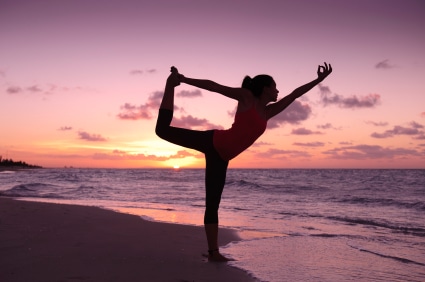 When you work out, your goals probably focus on building strength and endurance and burning fat. These are certainly worthy goals, but there’s an aspect of fitness you may be neglecting – your balance.
When you work out, your goals probably focus on building strength and endurance and burning fat. These are certainly worthy goals, but there’s an aspect of fitness you may be neglecting – your balance.
Why It’s Important to Work on Balance
Balance and agility skills are important if you’re an athlete, and having good balance skills becomes more important as you age. Falls related to poor balance are one of the most common causes of hip fractures in older people, and a broken hip can lead to an early demise. Though you may still be in the prime of your life, now’s the time to strengthen the neuromuscular connections that control balance and help you perform better in sports without the risk of injury.
A healthy sense of balance involves the interplay of a number of different systems. It requires input from nerves that lead from your inner ear to your brain, visual input, as well as input from your muscles. Exercises that challenge balance help to reinforce these connections. This is important regardless of what type of sport you participate in and what activities you do in your daily life.
Exercises That Improve Balance
Some forms of exercise such as tai chi, yoga and bicycling are well-known for improving balance skills. But you can improve your balance skills by incorporating balance challenges into your regular strength training routine.
When you do squats, do one-legged squats on your final set. This can be so challenging that you may have to hold onto a support at first, but it’ll add a whole new dimension to squat training. Don’t be surprised if it’s easier to do it on one side than the other. When doing upper body exercises such as biceps curls or triceps kickbacks, do them standing on one leg to add a balance challenge.
Use plyometrics to hone your balance skills. Do one-legged hops or place a line in the middle of the floor and jump back and forth over it. Speed skater plyometric exercises and two-legged jumps while rotating 180 degrees also improve balance. For the ultimate challenge, try jumping rope on one foot. These drills can easily be incorporated into your cardio routine.
Another way to build better balance is to do strength-training exercises on a Bosu balance trainer. A Bosu balance trainer has a flat, round base with a soft, squishy dome that creates an unstable surface. When you do exercises while standing or sitting on a Bosu trainer, you’re forced to use smaller stabilizing muscles to maintain your center of gravity. Another option is to do abdominal and core exercises on an exercise ball for a balance challenge.
You can even work on balance when you’re standing in line at the store. While you’re waiting for the person in front of you to get off their cell phone and stop holding up the line, balance on one foot, and hold it as long as you can. For additional points, do it with your eyes closed! It’s considerably more challenging when your brain doesn’t get visual input. When you’re brushing your teeth, close your eyes and balance on one leg for as long as you can. Even these simple exercises will improve your balance if you do them regularly.
The Bottom Line?
Even if your primary goal is to build strength and endurance, don’t neglect balance. Having good balance will make you a better athlete and reduce the risk of falls as you age. This is why I have included balance exercises in many of my new Low Impact videos.
References:
Rakel: Integrative Medicine, Second edition. “Balance and Agility”
Related Articles By Cathe:
How Good Are Your Balance Skills? And Why It Matters
Simple Ways to Improve Balance When You Work Out
What Does It Mean to Be Coordinated – and Can You Become More Coordinated as an Adult?
Are Dumbbells an Effective Substitute When You Don’t Have Barbells?
5 Ways to Improve Your Balance Skills When You Strength Train

